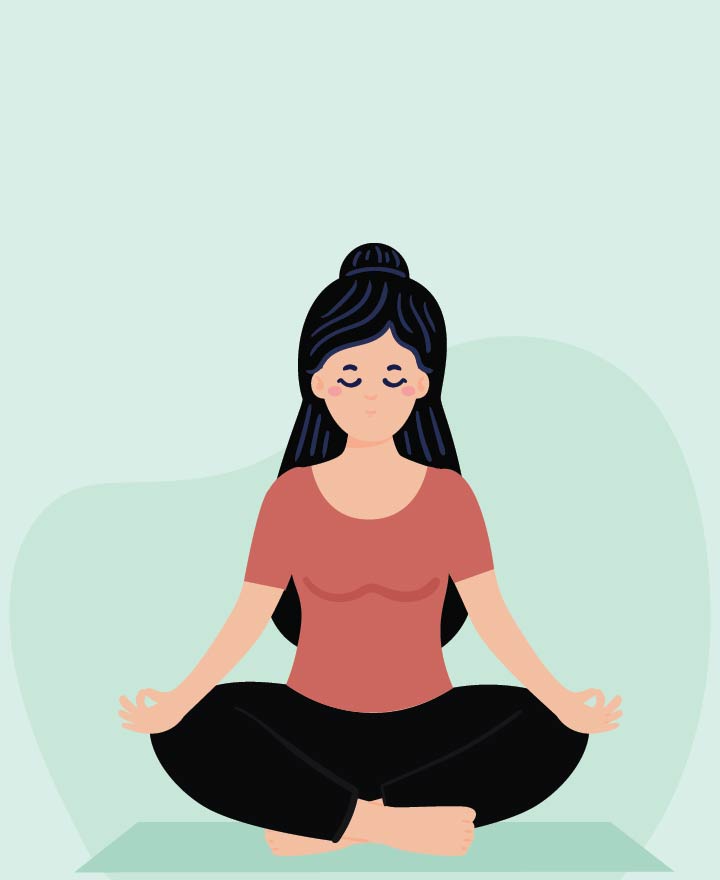

Yoga After Eating: Do's & Don'ts for Better Digestion
Problems with digestion are prevalent, particularly following meals. Including some simple yoga poses in your post-meal regimen can improve the functioning of your gastrointestinal tract and increase metabolism. But if you’re wondering whether can we do yoga after eating, then take a look at this article to know more.
Can you practice yoga right after eating?
It’s generally recommended to wait at least 30 minutes to an hour after eating before you practice yoga. In case if you have eaten a large meal, then wait until 2 to 3 hours. This is because doing yoga on a full stomach can make you feel uncomfortable and may interfere with your practice, as certain poses require bending and twisting that can compress the abdomen. If you start doing yoga right after eating, you may experience nausea, discomfort, difficulty in being flexible and controlling your breath.
However, there are few yoga asanas which can be done directly after eating to avoid indigestion and improve your gastrointestinal health.
Yoga Asanas That Can Be Done After Eating
After eating, its best to avoid intense yoga poses which involve deep twists or inversions. Instead, one must focus on gentle yoga poses. Here are some yoga asanas you can consider doing after eating:
1. Thunderbolt/Diamond Pose (Vajrasana)
This yoga asana relieves constipation, reduces stress, aids digestion, and improves sleep patterns.
• Sit on your heels with both toes touching and heels apart.
• Keep your back straight and place your hands on your knees.
• Take slow, deep breaths; relax in this posture.
• Stay in this position for at least five minutes.
2. Reclining at the Bound Angle Pose (Supta Baddha Konasana)
This yoga asana stretches the knees and inner thighs. By easing the muscles in the abdomen, this slouched position helps to relieve indigestion and other stomach discomfort. It helps relieve weariness, sleeplessness, stress, and restlessness.
• Begin by lying flat on your yoga mat; draw both legs closer so that your soles touch.
• Your shoulders should be in a relaxing position, away from the ears.
• Breathe slowly and deeply, and remain in this position for up to 60 seconds.
• Return to the starting position gradually.
While doing this asana, you can insert a comfortable cushion/pillow below the lower back to give the spine extra support.
3. Seated Cat-Cow Pose (Marjaryasana Bitilasana)
The cat or cow pose is believed to positively impact the female reproductive system while relaxing the muscles in the back, belly, chest, hips, and lungs.
• Sit on the floor and cross both legs in the sukhasana posture; your spine and hands on the thighs should remain stretched.
• Inhale, raise your chin, and open your chest; your back should remain arched.
• Exhale while burying your chin onto your chest.
• Repeat the steps with slow breaths
4. Cow-face Pose (Gomukhasana)
This yoga asana aids digestion and provides a soothing effect on the abdomen. It is particularly beneficial after a hearty meal. Gomukhasana assists in stretching and rejuvenating the entire body. It eases discomfort by causing the muscles to unwind. The cow-face position facilitates digestion and allows you to stretch the abdominal and spinal muscles.
• Take your left leg and position your ankle close to your left hip.
• Now, place your right leg on your left leg such that both your knees are in contact.
• Your right and left hands should touch, and the spine must be erect.
• You must remain in this position for 30-60 seconds.
• Repeat by alternating the positions.
5. Supine Spinal Twist (Supta Matsyendrasana)
This asana helps relieve stress and enhance mental and physical well-being. It aids digestion, massages the intestines, and strengthens the abdominal muscles, knees, quadriceps, and hamstrings.
• Extend your arms to the outside to form a triangle.
• Bring both knees closer to the chest while bending them.
• While maintaining an immobile posture, bend both knees to the right.
• Look to your left hand with your head turned to the left.
• Focus on taking long breaths while holding the twist for 30 seconds. Do the same on the other side.
Conclusion
Even though you can-do above-mentioned yoga poses after eating, remember to listen to your body and choose poses that feel comfortable and supportive after eating. Avoid any poses that cause discomfort or strain on a full stomach.
One of the important components of our overall wellness is also being financially secured. Healthcare emergencies can happen any time, but a good health insurance policy can protect you from such uncertain situations. To know more about Wellness and other health related tips, visit the wellness corner.
Source: healthshots.com, forceful-tranquility.com, onlymyhealth.com
Disclaimer: This blog provides general information and discussions about health and related subjects. The information and other content provided in this blog, website or in any linked materials are not intended and should not be considered, or used as a substitute for, medical advice, diagnosis or treatment. Kindly contact your Doctor before starting a new medicine or health regime.
Related Articles
4 Yoga Poses for Enhancing Blood Circulation
How To Incorporate Yoga Into Your Daily Routine
Yoga for Mind - Learn the Benefits and Techniques
Yoga Inversion - Benefits, Risks & Poses for Best Practice
Benefits of Bedtime Yoga - Poses For Better Sleep
Published on June 27, 2024














 Health Insurance
Health Insurance  Travel Insurance
Travel Insurance  Car Insurance
Car Insurance  Cyber Insurance
Cyber Insurance  Critical Illness Insurance
Critical Illness Insurance
 Pet Insurance
Pet Insurance
 Bike/Two Wheeler Insurance
Bike/Two Wheeler Insurance  Home Insurance
Home Insurance  Third Party Vehicle Ins.
Third Party Vehicle Ins.  Tractor Insurance
Tractor Insurance  Goods Carrying Vehicle Ins.
Goods Carrying Vehicle Ins.  Passenger Carrying Vehicle Ins.
Passenger Carrying Vehicle Ins.  Compulsory Personal Accident Insurance
Compulsory Personal Accident Insurance  Travel Insurance
Travel Insurance  Rural
Rural